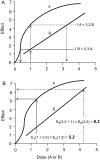Synergy: a concept in search of a definition
- PMID: 24002031
- PMCID: PMC3800760
- DOI: 10.1210/en.2013-1420
Synergy: a concept in search of a definition
Figures


Comment on
-
Understanding synergy.Am J Physiol Endocrinol Metab. 2013 Feb 1;304(3):E237-53. doi: 10.1152/ajpendo.00308.2012. Epub 2012 Dec 4. Am J Physiol Endocrinol Metab. 2013. PMID: 23211518 Review.
References
-
- Day JW, Ottaway N, Patterson JT, et al. A new glucagon and GLP-1 co-agonist eliminates obesity in rodents. Nat Chem Biol. 2009;5:749–757 - PubMed
-
- Greenway FL, Whitehouse MJ, Guttadauria M, et al. Rational design of a combination medication for the treatment of obesity. Obesity (Silver Spring). 2009;17:30–39 - PubMed
-
- Geary N. Understanding synergy. Am J Physiol Endocrinol Metab. 2013;304:E237–253 - PubMed
-
- Bliss CI. The toxicity of poisons applied jointly. Ann Appl Biol. 1939;26:585–615
Publication types
MeSH terms
Substances
Grants and funding
LinkOut - more resources
Full Text Sources
Other Literature Sources
Medical

